9 Signs Your Company Needs New Employee Scheduling Software
Employee scheduling is a challenging job. From training and scheduling to keeping employees motivated, managing a team requires the right tools.

Employee scheduling is a crucial aspect of managing a business, and implementing efficient software can alleviate many headaches. Let's explore signs that indicate your company could benefit from advanced employee scheduling systems.
1) Employee scheduling requires a full-time scheduler
If creating, updating, and managing the weekly schedule, along with handling vacation planning, has become a full-time job for at least one employee, it's a clear sign that your company could benefit from an advanced scheduling solution.
2) Difficulty in Finding Available Employees
As your company grows, finding available and qualified employees to fill empty shifts becomes increasingly challenging.
3) Over-Reliance on Overtime
An employee calls in sick – ideally this vacancy would be filled with a qualified straight time replacement. However, on short notice, you can’t find any equivalent replacements, so the vacancy is filled by holding a senior employee over on overtime.
4) Inaccurate Schedules
If your schedules require repeated corrections and amendments, leading employees to view them as rough guides rather than reliable plans, it's time to consider a more organized approach. Stable scheduling is a top priority for employees, and is also directly related to increases in revenue.
5) Disparate Information Sources
What a mess - your record of employee job qualifications is in numerous supervisor spreadsheets and post-it notes. Seniorities and their date ranges are in the HR system. Occupation rates are in the Payroll System. Employee special skills don’t seem to be recorded anywhere and vacation planning is carried out on an old in-house system. When crucial scheduling information is scattered across various systems and documents, it can lead to confusion and inefficiencies.
6) Back-to-back shifts are causing employee burnout
Complaints of burnout from employees working back-to-back shifts can be a sign that your scheduling practices need adjustment to ensure employee well-being. There is strong evidence in connecting bad scheduling practices— (including short notice of work schedules, irregular work schedules and hours, canceled shifts, and on-call shifts) —to psychological distress, worse sleep quality, unhappiness, worker fatigue, and an increased risk of occupational injury.
7) Grievances Due to Unfair Scheduling
Unequal or unfair scheduling practices can lead to formal grievances from employees, highlighting the importance of fair and transparent scheduling.
8) Disconnected Time Entry and Schedules
If preparing schedules and entering time for payroll are separate and disconnected processes, it can lead to errors and inefficiencies in payroll calculations. Failure to calculate payroll correctly, creates grievances and can put you on the hook for back taxes, interest, and penalties.
9) Information "Silos" for Time Off Requests
Managing sick leave, vacation, FMLA, and other time off requests in separate systems can make it challenging to track and manage employee time off effectively. You can’t get a full picture of the company’s liabilities.
By addressing these signs and implementing an advanced employee scheduling system, such as WorkSight Flow, you can streamline your scheduling processes, improve employee satisfaction, and enhance overall operational efficiency. Visit www.worksightflow.com to learn more about how advanced scheduling software can benefit your company.





